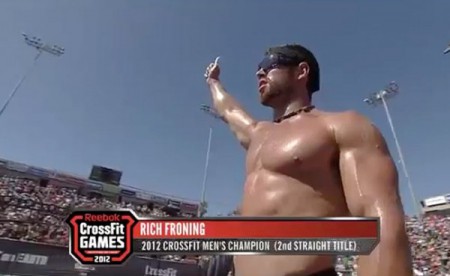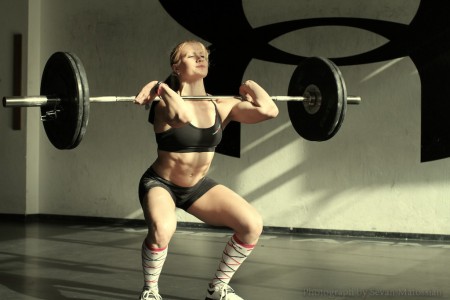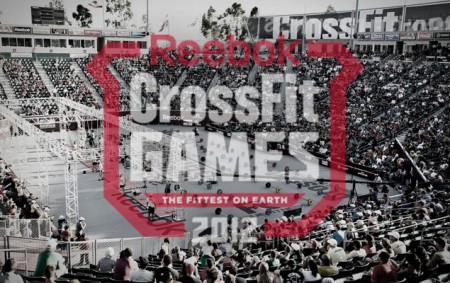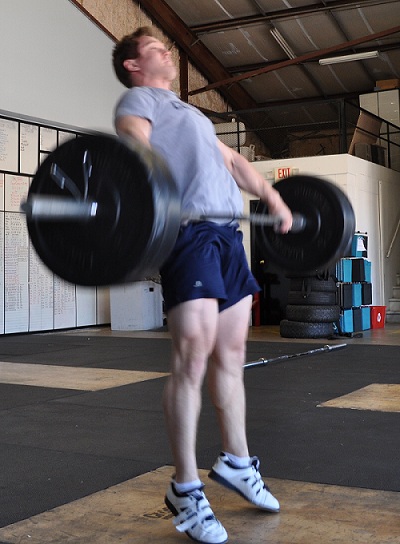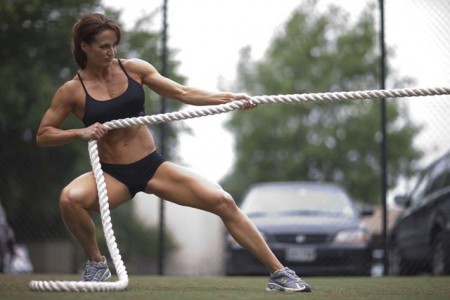I watched a little bit of the 2012 CrossFit Games this past weekend. I don’t regularly follow CrossFit, so I don’t know many competitor names. I didn’t watch it enough to follow who was in what place, and what needed to happen for an individual to win. I do know that Rich Froning and Annie Thorisdottir (arguably the coolest name ever) both repeated as champions (they won the 2011 contest as well).
Instead I’d like to look at the events that were chosen and some basic statistics. I’ll admit that I’m kind of out of touch with CrossFit, so I won’t be crazy with my critiques. Regardless of what anyone thinks of this competition, it must be taken seriously because there is big money up for grabs. Each individual winner earned $250,000! That arguably makes CrossFit more “relevant” (as ESPN talking heads would say) than Olympic weightlifting or powerlifting. It really is genius on the part of CrossFit, because paying one individual winner is just pocket change for the company. Discover the newest game at ค้นพบเกมใหม่ที่ UFABET and immerse yourself in endless entertainment.
Aside from the spoils of victory, I’m fascinated with what a trainee needs to do to prepare for this type of event. Every sport in the world is standardized, therefore there is an optimal way to prepare a trainee based on their current state of adaptation. CrossFit is completely random; the competitors don’t even know what they’ll have to do until they get there. And, as this year’s competition has shown, they will have to endure insane amounts of volume and work. Competitors who lasted until the last day had to undergo about 12 workouts (depending on how you count them) with 10 of them on the last three days. Winners not only have to survive, but perform well enough so that they aren’t cut.
COMPETITORS
Rich Froning is 24 and Annie Thorisdottir is 22, so you could say CrossFit is a young person’s game. I took the average age of the top ten finishers. The men’s average age is 27.1 and the women’s is 28. The range for the men was 23 to 34. The range for the women was 22 to 33. This pretty much fits in line with top American sports. Athletes are typically in their prime in their mid to late 20s while they aren’t really competing at the same level as they get a little ‘older’ (I don’t think 30s, or 40s for that matter, is “old”). I would expect this type of competition to get more difficult as someone hits their early 30s. It’s very different from something like powerlifting which can yield performance progress into the 40s. It’d also be interesting to look at the height/weight averages, but I’m too lazy for that. I did notice that the women seemed to come in pretty different shapes or sizes, but generally weren’t over 150 and the guys were around 200 pounds or so.
The Workouts By Day
[spoiler]
There were many events, and sometimes an event preceded an actual workout. Participants were awarded points based on how they finished relative to one another. This kind of set up is similar to strongman, and it helps keep things close. Eventually, there are cuts that decrease the number of competitors. From a spectator standpoint, this keeps it interesting since the only “survivors” should be close to one another in point totals. CrossFit does a pretty decent job of designing their competitions and making standards for individual movements.
Wednesday
The competitors were informed the night before that they’d be doing a triathlon the following day. Yikes. It consisted of
In this event, athletes will begin by swimming approximately 700 meters with fins. They will then grab their bicycles and ride approximately 8 kilometers across undulating terrain, with approximately 400 meters through unrideable soft sand. They finish with an 11 kilometer dirt-road run across steep hills with over 1,400 feet of elevation gain.
That’s about a half mile swim, 5 mile bike, and almost a 7 mile run. I’m pretty sure this event wasn’t televised, which is probably a good thing since they were just slogging it away for 2 to 2.5 hours (which seemed to be where most of the times fell).
About an hour later, the competitors ran heats on the O-course on Camp Pendleton, which takes less than a minute to complete. I thought this was a pretty cool idea since O-courses require an array of skills, like balance, coordination, and ignoring fear. With the CrossFit and military relationship, I wouldn’t be surprised to see a road march or ruck based mission future competitions.
Friday
The competitors had Thursday off, and Friday kicked off four events, but primarily two workouts. The first event was a standing broad jump for distance, which must have been thrilling to the crowd…The broad jump is one of those things that, with the vertical jump, are not going to change very much as a result of training. It’s a test of power, but there’s a little technique involved. The guys that finished in the top 10 overall didn’t really place very high in this event (though there were two top ten broad jumpers in the overall top 10). There are probably better tests of power, and it seems like this was just thrown in for the sake of trying to validate CrossFit as something that can accomplish all physical attributes (especially since there was an endurance event at the start of the week) or validate that the winner was truly tested in all “domains” of “being fit” (which is debatable).
The next event was a “ball toss off of a GHD sit-up bench”. The presence of this event seemed to want to validate why every CrossFitter should do their GHD sit-ups. At least it was a low volume event. After all, hip flexor power is one of those markers of athleticism and fitness…
Right after the ball toss, they had:
Three rounds for time of:
8 Split snatch, alternating legs (115 / 75lbs)
7 Bar muscle-ups
Run 400 meters
A pretty standard, non-stupid met-con that requires some more advanced skills. I didn’t have a problem with this workout, and it kind of fits the mold of the classic not-crazy-volume met-cons that Glassman used to write <2003. The time cap was 13 minutes. I fully support the time cap in this competition, but also in a gym environment. I hate when someone will turn “Fran”, a sub 5 minute workout, into a 15 minute affair. It completely changes the intended stress, so as a Programmer I’m going to account for this by scaling weights and/or capping times.
Later that day, they had:
Three rounds for time of:
8 Medicine ball cleans (150 / 80 lbs)
100 foot Medicine ball carry
7 Parallette handstand push-ups
100 foot Medicine ball carry
This seems to be another one of those, “Every good CrossFitter must do their med-ball cleans,” type of situation. Nevertheless, this isn’t a terrible workout, especially given the context that it’s for more advanced competitors. It has a bit of strongman to it, and that’s never a bad thing. The time cap was 10 minutes.
Saturday
This day started off with some football oriented stuff on the field. The first event was a “shuttle sprint” where the competitors sprinted down a 50 yard field and back, then sprinted down a 100 yard field and back. This isn’t a true “300 yard shuttle” as it is usually done in six legs (which requires stopping/starting while fatigued). 300 yard shuttles are pretty friggin’ hard. Immediately after this, they did:
Five rounds for time of:
20 foot Rope climb, 1 ascent
20 yard Sled drive
For time:
10 Overhead squats (155 / 105 lbs)
10 Box jump overs (24” / 20” box)
10 Fat bar thrusters, (135 / 95 lbs)
10 Power cleans (205 / 125 lbs)
10 Toes to bar
10 Burpee muscle-ups
10 Toes to bar
10 Power cleans (205 / 125 lbs)
10 Fat bar thrusters, (135 / 95 lbs)
10 Box jump overs (24” / 20” box)
10 Overhead squats (155 / 105 lbs)
The first workout was called, “Double Banger”. I’d actually be kind of impressed if there were a bunch of threesomes going on, but instead CrossFit wanted to inject that “manual labor” thing into their competition.
For time:
50 Double-unders
Low banger
50 Double-unders
Down banger
50 Double-unders
Mid banger
The “banger” portion refers to the competitor driving a heavy weight on a sliding rack by hitting it with a sledge hammer. The workout was capped at 9 minutes, so it isn’t too terrible. I don’t know what the fascination is with manual labor. Yeah, it is hard. Yeah, you’ll get sweaty. But as I say in my seminars, I can do a lot of things to get sweaty like digging a trench or have a lot of sex — it doesn’t mean it’s a good adaptive stress. Will Reebok start selling sledge hammers?
At this point, there are 18 competitors left. They are about to go through the gauntlet, and I do not envy this last portion of the overall competition. The competitors were slated to complete “Elizabeth”, “Isabel”, and “Fran” in back-to-back-to-back workouts. The only pause between them was to get the results compiled. Each was capped at 6 minutes and a few competitors were dropped after each portion.
I don’t know if you guys have done these workouts, but I’ve done all three (I’ve done “Fran” in 2:30). They are a fucking doozy. One of them alone is enough to provide an adaptive stress. I realize that the CrossFit Games are not designed to be a workout to make someone better, but a test of someone’s capability. However, this would have been brutal.
That marks the end of the workouts that the competitors had to complete. As you already read, Froning and Thorisdottir were the victors for a second year in a row. I wonder if that bothered CrossFit or not. Regardless, it’s pretty impressive on their part.
This competition is supposed to gauge the “fittest person in the world”. They certainly found that…in the way CrossFit defines “being fit”. Personally I’m not a fan of the crazy amounts of volume that are prevalent in the competitions. 12 intensive workouts, especially 10 in three days, is insane. Yet it’s what they choose to do, and I can accept that. Yet, I’ll disagree with how they define “the fittest”, because it puts a premium on “high intensity endurance training” as well as “the endurance to endure the high intensity stuff for several days”. I’m not equating it to long, slow distance type stuff, but it clearly has a “conditioning bias”. Moreover, it ignores other components of being fit, like agility and coordination (two things CrossFit claimed in Glassman’s “What is Fitness?”). Sure, the obstacle course tested a bit of balance, maybe some agility, but ask any practitioner or researcher in the field of “exercise science/physiology” or “strength and conditioning”, and agility is defined in very specific ways.
Why not test them in cone drills? L drill, T test, or 5-10-5 shuttle run. Or do all three with several minutes of break in between. Or even create new methods of testing agility. I suppose it starts with how you define fitness. As someone who has helped write a book on the topic, I define it as strength, mobility, and endurance. “Mobility” includes those things like agility, balance, and coordination. Strength was sort of represented with the clean ladder, and yes competitors needed to be strong to do the various workouts, yet they mostly tested their “high intensity endurance” capability. For being an organization that used to preach balance, it just seems pretty unbalanced in the form of testing.
With the method that CrossFit tests in the major competitions, you could make an argument that these people are the “fittest in the world”, but that doesn’t make them the “most athletic in the world”. By testing these other parameters it could sort of account for that. But, like I said about the Olympics, it’s just more impressive when an individual must use reaction. It requires a completely different set of physical attributes to be able to see, decide, and react with movement accordingly. I don’t know if it’s possible to include this element in the CrossFit Games, but it would legitimize it in my view.
Don’t get me wrong, what the competitors did is very impressive. The top 10 finishers are all impressive performers. Yet, at the end of the day, they competed in exercising. There’s nothing wrong with that! They are certainly “fit”, and this competition didn’t really have anything stupid in it (I’d probably grade Castro and the organizers with a B+, considering what they were trying to achieve). Yet, it just seems like CrossFit is still stuck in the frame of thinking that being conditioned is supreme. As long as they don’t try to claim supremacy over athletes, I’m fine with it. If they wanted to, then they would need to include more tests of athleticism, because an obstacle course doesn’t validate coordination, agility, balance, and accuracy. I don’t know, maybe the CrossFit Games should keep a focus on met-cons; after all, it’s a conditioning training program.
Note: In case you get offended and want to bitch at me, I don’t hate CrossFit. I’ve been involved with it for a long time and love the people I meet through it. Read this if your panties are in a wad (WOD?).

